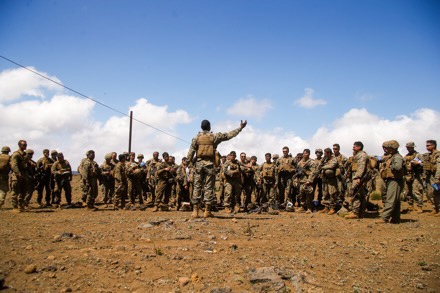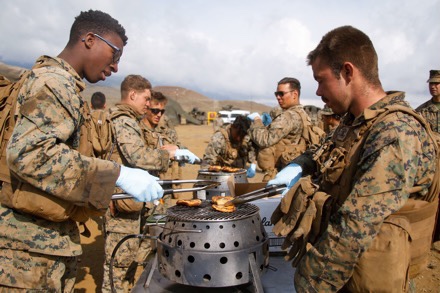KANEOHE BAY, Hawaii —
U.S. Marines with 1st Battalion, 12th Marines, 3rd Marine Division experimented Twenty-First Century Foraging concepts during Spartan Fury 22.1 at Pohakuloa Training Area, Hawaii, March 2022.

Twenty-First Century Foraging concepts enable commanders to extend and enhance operational rations for a period without needing outside logistics support. “It is imperative that the Marine Corps logistics functions continue to adapt to force design and the future warfighting concepts. That includes reducing our logistical footprint,” said Lt. Col. Richard Neikirk, commanding officer of 1st Battalion, 12th Marines.
During the exercise, individual Marines procured dry goods and fresh produce from local suppliers utilizing cash 1105 funds. The Marines were able to find and purchase eggs, sausage, bacon, chicken, rice, and canned vegetables. The food was brought back to the training area where the Marines experimented with various field cooking methods.
“It is imperative that the Marine Corps logistics functions continue to adapt to force design and the future warfighting concepts. That includes reducing our logistical footprint”
Lt. Col. Richard Neikirk, 1st Battalion, 12th Marines commanding officer
The Marines used lightweight, expeditionary, non-organic food service equipment such as individual cooking stoves, volcano grills, and the Expeditionary Food Service Trailer that is currently being developed by the Fort Lee Instructor staff. This equipment is designed to be sustainable for long durations in austere environments and will be employed by the lowest level of any unit and in any environment.
The food was able to feed the battery for three days with two cooked meals a day. The warm meals were a welcomed change from the self-contained, individual field rations that are typically consumed in the field. By cooking and procuring food, the battery proved that it could sustain itself without outside support for a duration of time. Limiting the need for outside logistics support enhances a unit’s ability to be adaptable, mobile, and lethal.

The experimentation allowed the Food Service Specialist accompanied by the Marines in the battery to exercise foraging concepts in a CONUS training environment. “This trial period allowed the Fort Lee Instructor staff to gain real life data and procedural analysis,” said Capt. Norman Bunch, operations officer at Marine Detachment Fort Lee.
The data collected during Spartan Fury 22.1 will be used to develop future training and readiness standards as well as the future periods of instruction for Entry Level, Non-Commissioned Officer, and Staff Non-Commissioned Officer Courses.
By Staff Sgt. Olivia Knapp


“Teriyaki Spam anyone?”
Once upon a time, units had their own cooks and clerks. They were cut out to save overall personnel, but at a cost. T-rats are considered Class A meals even though they are a big version of an MRE. Reheating them in a big pot of water isn’t exactly cooking.
Hopefully this makes a comeback in the Army, cooking locally-sourced food shouldn’t just be the domain of KBR.
If they need personnel billets they can always cut Pentagon slots…
I would def be scouting all the local mom & pop shops/Crack Seed Stores for the following – spam musubi, pork hash, kalua pork, lau lau, huli huli chicken, etc. Broke da mouth!
I think the big takeaway is that smaller conventional USMC and Army units can self-procure at least a portion of their sustainment requirements locally. However, there are some other challenges with this concept beyond food. Potable water being the biggest that comes to mind. Lots of places in the world don’t have bottled water readily available and local “dug wells” likely won’t have the capacity to support many more people than are already getting the water from that source – at any price. Likewise, there probably won’t be any local sources of JP8 to fill fuel tanks. Most of the vehicles and generators now in the inventory won’t run very well if at all on the low-grade diesel fuel found in much of the world. Finally, even for food, this won’t work for larger units that would instantly “over harvest” the local food supply. So, this is not for Battalion sized formations – unless you are operating in or adjacent to a good-sized urban area. From my experience, getting the food properly cooked once you have it is a much more manageable problem to solve. Still, I’m very glad they are conducting these kinds of experiments.
TLB
The Iowa National Guard has been way out ahead of this for years. We eat well at every AT.
They rediscovered the MKT.
The death of hot “A” rations in the Army was tragedy. Yes, I understand that the T ration is easier from a logistics standpoint, but there was a real morale boost in having a hot A rat. I lived through the transition. This should have happened 30 years ago.